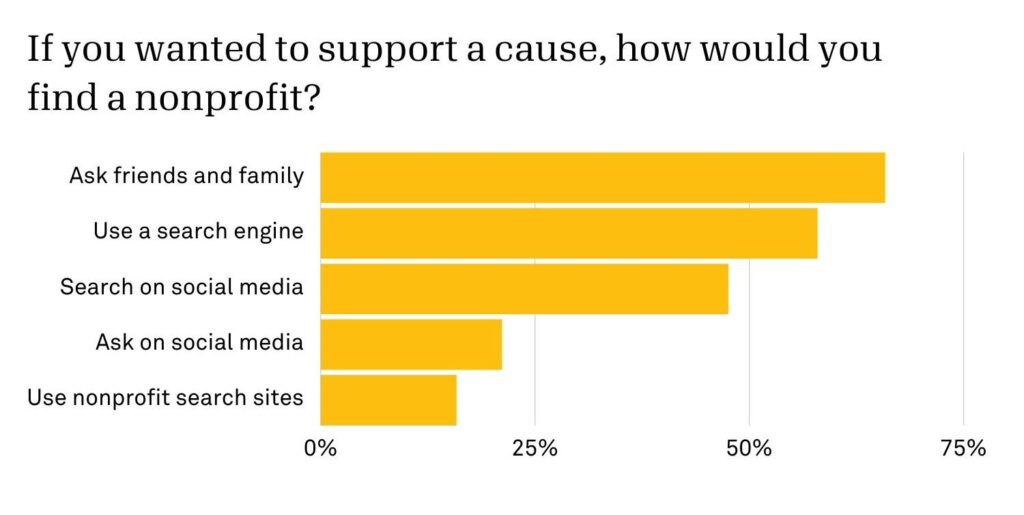Reaching Gen Z on social media: Expert advice vs. Gen Z opinion

As a member of Generation Z (Gen Z), or today’s 11- to 26-year-olds, I have been curious about the advice given to nonprofits on capturing younger audiences’ attention. While I’m not an expert, I’d say that some of the tips out there seem pretty accurate. For example, our preference for video content rings true. But other suggestions, like using pop culture slang and memes to catch Gen Z’s shorter attention span, feel a little off.
As I dug into the advice, I couldn’t help but reflect on the way I engage with nonprofit social media: Is the use of humor and short-form video crucial for brands to grab my attention? What does it even mean for a brand to be authentic?
To answer these questions and put experts’ advice to the test, I decided to ask my peers.
Exploring today’s top advice for reaching Gen Z
Before I get into what my Gen Z peers had to say, it’s helpful to consider some of the most popular advice given to nonprofits on how to best engage members of my generation.
Experts say that Gen Z:
- Wants to see impact through storytelling, primarily through social media videos.
- Prefers to discover and engage with nonprofits via social media, particularly TikTok, YouTube, and Instagram.
- Has a shorter attention span, which requires content that is skimmable.
- Is more likely to support organizations that have strong brands and social media accounts.
- Feels loyal to organizations that align with their values and have a positive impact on the world.
- Wants to hear from real people, especially from other younger people.
- Views giving in non-traditional ways, including a strong preference to donate time.
- Prefers language that is both relatable and easy to understand (with some experts saying it’s important to use their slang).
But to truly understand how nonprofits can best engage Gen Z on social media, we thought it was important to bring my generation’s voice into the conversation.
Adding Gen Z’s perspective to the picture
To put today’s expert advice to the test, we created a short survey that asked Gen Z about their use of social media as it relates to philanthropy. Questions included how members of this generation find out about new nonprofits, how they know they could trust a nonprofit, and how they prefer to get information from nonprofits.
We received 38 total responses from university students, young professionals, high school seniors, and members of the military, ranging in age from 18 to 25 years old. While this is a small sample size, it was highly targeted to people interested in nonprofits.
The results included a couple of surprises and reinforced some of the expert advice. Here are the top takeaways.
- When asked what would inspire trust in a nonprofit, 52% of respondents mentioned “evidence of impact,” and 44% cited “reliable reviews/trusted sources.”
- When ranking factors that motivate them to support a nonprofit, 53% indicated “an urgent need related to disaster, crisis, or tragedy” as the most motivating, while 47% ranked “clear evidence of impact” the highest.
- When asked about the ways they’re most likely to support a nonprofit, 39% of respondents selected “interact with & share their social media.”
- Instagram was the most selected method for nonprofits to contact Gen Z, followed by email and text message.
- When asked how they would find a nonprofit to support, 67% said they would “ask friends or family,” and 59% said they’d “search for options on a search engine.”


Based on these findings, the experts are right about one thing: Gen Z needs to see evidence of impact from nonprofits, and they prefer to hear it from people they trust, whether through friends, family, familiar influencers, or first-hand testimonials.
Contrary to experts’ popular belief, using TikTok, memes, or trendy slang is not required to earn Gen Z’s confidence. In fact, none of our respondents mentioned viral, humorous, relatable, or video content as an important factor in finding or supporting nonprofits.
Lastly, Gen Z’s view of charitable giving is not confined to conventional means. In fact, my generation sees sharing a nonprofit’s message on social media as a form of nonprofit support.
What it means for Candid (and your nonprofit)
With this information, here is what Candid is planning to test to reach and engage Gen Z audiences online.
- Invest in Instagram. Instagram was the most popular option for getting information about nonprofits. Our efforts will include developing content that prioritizes Instagram’s algorithm, such as using videos to create an experience that is exciting and approachable.
- Experiment with creating more engaging emails. A surprisingly high number of respondents indicated that they’d want to communicate with nonprofits in this way. To make these more engaging, we’re going to test using different images, calls to actions, and subject lines.
- Prioritize shareable content. Sharing on social media can be viewed as a form of generosity. So, we’re going to lean into that by creating content that people want to share, whether using inspiring quotes or taking a slightly more fun approach to educational videos.
- Investigate working with social sector influencers (not celebrities). Seeing that influencers can inspire trust among Gen Z, we’re going to explore this approach for the first time. In the meantime, we will focus on creating content that features real Candid staff and showcases the work we’re doing.
Overall, Gen Z wants to see a nonprofit’s impact. They want to know that their investment in your nonprofit is really going to make a difference. And once a nonprofit has demonstrated that, my generation will likely stay loyal to the causes they care most about.







Chris Norman, CFRE says:
Well written and very useful information. Thank you.
Christine Mychajliw says:
Great job! This is important information. Keep it coming. :-)
Tod Thomas says:
Thanks so much for this great article! We have been working on reaching the next generation of givers here at United Way of the Big Bend. We have a great brand presence, but we are considered your Grandfather's nonprofit with payroll deductions. Reaching out to Gen Z is a priority for us.